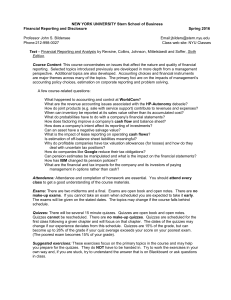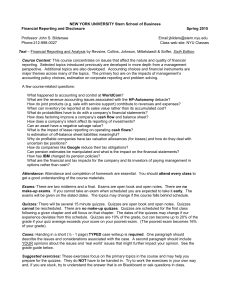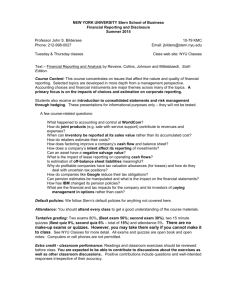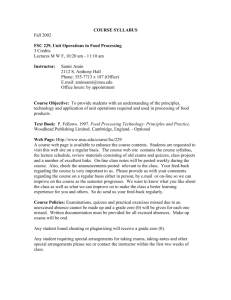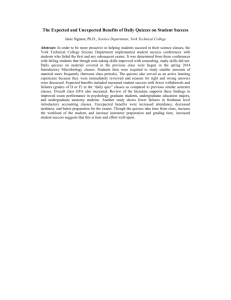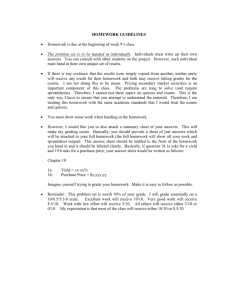NEW YORK UNIVERSITY Stern School of Business
advertisement
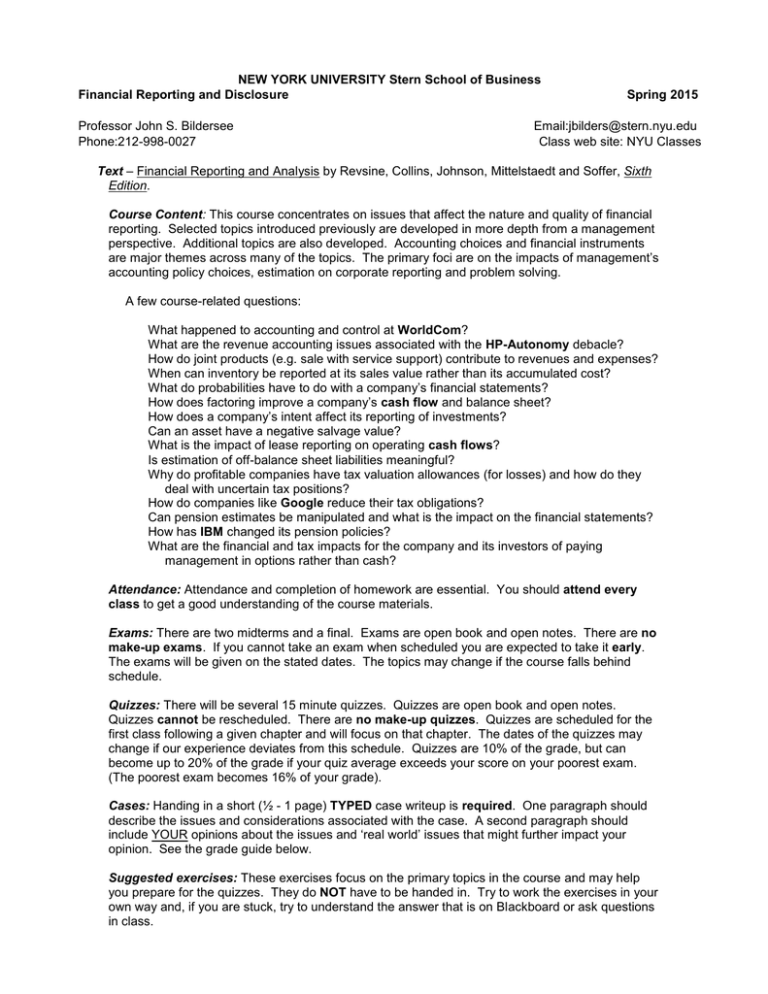
NEW YORK UNIVERSITY Stern School of Business Financial Reporting and Disclosure Professor John S. Bildersee Phone:212-998-0027 Spring 2015 Email:jbilders@stern.nyu.edu Class web site: NYU Classes Text – Financial Reporting and Analysis by Revsine, Collins, Johnson, Mittelstaedt and Soffer, Sixth Edition. Course Content: This course concentrates on issues that affect the nature and quality of financial reporting. Selected topics introduced previously are developed in more depth from a management perspective. Additional topics are also developed. Accounting choices and financial instruments are major themes across many of the topics. The primary foci are on the impacts of management’s accounting policy choices, estimation on corporate reporting and problem solving. A few course-related questions: What happened to accounting and control at WorldCom? What are the revenue accounting issues associated with the HP-Autonomy debacle? How do joint products (e.g. sale with service support) contribute to revenues and expenses? When can inventory be reported at its sales value rather than its accumulated cost? What do probabilities have to do with a company’s financial statements? How does factoring improve a company’s cash flow and balance sheet? How does a company’s intent affect its reporting of investments? Can an asset have a negative salvage value? What is the impact of lease reporting on operating cash flows? Is estimation of off-balance sheet liabilities meaningful? Why do profitable companies have tax valuation allowances (for losses) and how do they deal with uncertain tax positions? How do companies like Google reduce their tax obligations? Can pension estimates be manipulated and what is the impact on the financial statements? How has IBM changed its pension policies? What are the financial and tax impacts for the company and its investors of paying management in options rather than cash? Attendance: Attendance and completion of homework are essential. You should attend every class to get a good understanding of the course materials. Exams: There are two midterms and a final. Exams are open book and open notes. There are no make-up exams. If you cannot take an exam when scheduled you are expected to take it early. The exams will be given on the stated dates. The topics may change if the course falls behind schedule. Quizzes: There will be several 15 minute quizzes. Quizzes are open book and open notes. Quizzes cannot be rescheduled. There are no make-up quizzes. Quizzes are scheduled for the first class following a given chapter and will focus on that chapter. The dates of the quizzes may change if our experience deviates from this schedule. Quizzes are 10% of the grade, but can become up to 20% of the grade if your quiz average exceeds your score on your poorest exam. (The poorest exam becomes 16% of your grade). Cases: Handing in a short (½ - 1 page) TYPED case writeup is required. One paragraph should describe the issues and considerations associated with the case. A second paragraph should include YOUR opinions about the issues and ‘real world’ issues that might further impact your opinion. See the grade guide below. Suggested exercises: These exercises focus on the primary topics in the course and may help you prepare for the quizzes. They do NOT have to be handed in. Try to work the exercises in your own way and, if you are stuck, try to understand the answer that is on Blackboard or ask questions in class. Extra credit - classroom performance: Readings and classroom exercises should be reviewed before class. You are expected to be able to contribute to discussions about the exercises as well as other classroom discussions.. Positive contributions include questions and wellintended responses irrespective of their accuracy. Support materials: Visit NYU Classes early and often. It has announcements, class notes, slide shows, spreadsheets, sample exams and miscellaneous articles. Many of the relevant materials will be provided as handouts. Default policies: Policies not outlined here will be covered by the Stern default policies document attached to this syllabus. You are expected to follow the undergraduate code of conduct and the graduate honor code throughout the semester. Tentative Schedule: Topic Readings Overview/Revenue Recognition Revenue Recognition 2* (60-72), 3 Revenue Recognition 3 Inventories 9 Inventories 9 (inc App. B & C) Inventories 9 (inc App. B & C) FI-Receivables FI-Receivables FI-Minority (Noncontrolling) Investments FI-Noncontrolling& Majority (Controlling) Investments FI-Majority investments** FI-Liabilities/Review First Exam FI-Liabilities FI-Hedges**,Leases FI-Leases FI-Leases FI-Pensions FI –Pensions/Review Second Exam Fl-Pensions Taxes Taxes Taxes Classroom Discussion E3-2, E3-3 E3-7, E3-12, P3-6 E9-8, E9-9 P9-16[1-2] E9-13, C9-2 8 8 E8-6, P8-8 E8-14, P8-11, P8-13 16 (953-966) (inc App A) E16-2, E16-3 Suggested Exercises Case-Velocity Cellular E3-20, P3-5, (Quiz-Chp 3) E9-10, E9-14, E9-17, E919 (Quiz Chp 9) E8-13, E8-15, (Quiz-Chp 8) 16 (953-966 & 966-970) E16-4, E16-5 16 (958-961) E16-7, E16-9 11 (601-633) E11-6, E11-8 E16-1, E16-10 (Revenue recognition through minority investments) E11-3, E11-9, E11-12, 11 (601-633 & 652 -656) P11-7, P11-11 12(inc Appendix) E12-3, E12-4, E12-12 E11-11, P11-1 E12-1, E12-6, E12-7, E1212 15 12 E12-13,P12-18 Case-Bear Minimum E12-2, E12-5, E12-8, (Quiz-Chp 12) 14 E14-1, E14-2 14 E14-7, E14-11, P14-7 (Liabilities through leases) 14 E14-8, E14-13, E14-14 Case-Rump Organization E14-6, E14-9, E14-12, 13 E13-3 E14-20, P14-3 (Quiz-Chp 14) 13 E13-6, E13-13 13 E13-14 E13-1, E13-2, E13-15 (Quiz-Chp 13) 15 (889-911. 924-931) E15-12, E15-13, E15-14 15 (911-924) E15-16 E15-15, P15-4 Owners’ equity and EPS Executive Compensation Review Third Exam (Pensions through executive compensation) *It is assumed that you are familiar with the materials in the appendices to chapters 2 and the end of the text. ** An introduction – not on any exam – presentation depends on meeting the course schedule. Tentative Grading: Test 1 Test 2 Test 3 Quizzes Cases Attendance Classroom participation 26 points 26 points 26 points 10 points 6 points 6 points Extra credit Selected Topics: Revenue/expense recognition Joint Products Percent of Completion Installment Sales Commodities Inventory LIFO-FIFO (multiyear) Writedowns Dollar Value LIFO Retail Methods Receivables Factoring SPEs (Special Purpose Entities) Discounts Troubled Debt Restructuring Minority investments Fair Value Hierarchy Available for sale securities Trading securities Equity method Majority Investments Consolidations Leases Taxes Pensions Owners’ equity Lessee Lessor Guarantees Sale-leasebacks Temporary deferrals Permanent deferrals Tax loss carrybacks and carryforwards Tax valuation allowance Uncertain Tax Positions Pension trust fund Projected obligations Service costs Assumptions Accruals vs. Fair & Present Value Treasury stock Simple EPS Diluted EPS Security conversions Executive compensation Case guide outline: Cases must be typed. Written material will not be accepted or reviewed. The amount of credit will be guided by this summary. Be concise; assume you are summarizing the relevant issues for management. Use at least 1½ line spacing, normal page borders and size 11 font. There is a one page limit per case. Dimension Statement of the Issues and driving Forces Poor Partial recognition of the factors Average Identification of the factors Excellent Thorough identification of the factors and their impacts Opinion Based on the Above Failure to link factors to your opinion Partial integration of the identified factors into your opinion Full integration of the factors into your opinion
